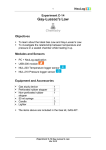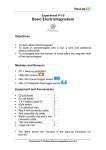Download Experiment B-41, The Lungs and Spirometry
Transcript
1 Experiment B-41 The Lungs and Spirometry Parameters Objectives To learn about the mechanism of breathing. To learn about lung volumes and capacities. To compare these parameters before and after physical activity. To compare these parameters among different students. Modules and Sensors PC + NeuLog application USB-200 module NUL-216 Spirometer logger sensor Materials Spirometer papers (included with the sensor) Experiment B-41 The Lungs and Spirometry Parameters Ver 3.0.2 2 Introduction The chest contains two lungs made up of sections called lobes, and are protected by the ribcage. The lungs bring oxygen into the body and remove carbon dioxide. Air is breathed through the nose, mouth or both. The nose is the preferred route since it is a better filter for large particles than the mouth. However, when a large amount of air is needed, the mouth route is better. The diaphragm is a large muscle located under the lungs. Inhalation occurs when the diaphragm moves down, the ribs flare outward, the lungs expand and air is drawn in. Exhalation occurs when the diaphragm relaxes and air leaves the lungs. How much air do we breathe? The normal amount of air that we breathe in and out when we are at rest is called tidal volume (TV). An average tidal volume is around half a liter. We can also inhale a very large amount of air and then exhale all the air we can, the volume of that exhaled air is called our vital capacity (VC) (typically 3.1-4.8 liters). We cannot exhale all the air from our lungs. There is approximately 1.2 liters of air that remains in our respiratory tracts; it is called the residual volume (RV). The total amount of air that we can hold (the vital capacity plus the residual volume) is the total lung capacity (TLC). Its volume is approximately 4.2-6 liters. Experiment B-41 The Lungs and Spirometry Parameters Ver 3.0.2 3 Procedure Experiment setup 1. Make sure you have spirometer papers so that several students can use the same spirometer one after the other. Note: The spirometer logger sensor is designed for educational use only and may not be used for medical diagnose. If you suffer from asthma or you are not feeling well, do not conduct this experiment. Sensor setup 2. Connect the USB-200 module 3. Check that the spirometer sensor USB-200 module. to the PC. is connected to the Note: The following software functions are explained in short. It is recommended to practice the NeuLog application functions (as described in the user manual) beforehand. 4. Run the NeuLog application and check that the spirometer sensor is identified. Experiment B-41 The Lungs and Spirometry Parameters Ver 3.0.2 4 Settings 5. Click on the On-line Experiment icon main icon bar. 6. Click on the Experiment Setup icon in the NeuLog and set the: Experiment duration to 1 minute Sampling rate to 10 per second Testing and measurements Note: This experiment should be carried out in pairs. 7. Role the paper and insert it into the larger inlet of the spirometer. While one student breathes in and out through the spirometer sensor, another student should start the experiment and keep track of it. 8. Tightly attach your lips to the rolled paper and block the air flow through your nose with your hand or a clip. Experiment B-41 The Lungs and Spirometry Parameters Ver 3.0.2 5 9. Click on the Run Experiment icon measurement. to start the 10. Breathe regularly in and out a few times. Afterwards, inhale as hard as you can and then exhale as hard as you can. Keep on breathing regularly for a few times and stop the experiment. 11. Click on the Area icon 12. In order to focus on the desired range, click on the Zoom . icon , locate the mouse cursor at a point above the graph and press its left button; keep it pressed and create a rectangle that includes the whole range. 13. Your graph should be similar to the following: 14. Save your graph. 15. Using the "Area" function we can calculate the tidal volume (TV) and the vital capacity (VC). Experiment B-41 The Lungs and Spirometry Parameters Ver 3.0.2 6 16. Click on the Select zone icon and choose an area of the graph that incudes a regular inhale or exhale. Click on the Show functions icon 17. . You will notice that the area beneath the curve is calculated. The area is equal to the tidal volume (TV), which in the sample experiment is 0.19 L. Experiment B-41 The Lungs and Spirometry Parameters Ver 3.0.2 7 18. Repeat these steps but this time choose the part of the measured maximum exhaled air. This is the vital capacity (VC), which in the sample experiment is equal to 3.92 L. Challenge research 19. Measure your tidal volume after some physical activity. 20. Compare your results with other students. Summary questions 1. How much is your estimated total lung capacity (TLC)? 2. How did the physical activity affect your tidal volume? Explain. 3. What were the differences among different students? What were the differences between boys and girls? Explain. Experiment B-41 The Lungs and Spirometry Parameters Ver 3.0.2









